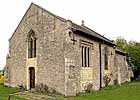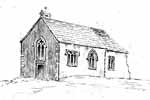 Sookholme Sookholme
St Augustine
History
The church at Sookholme is a small building dating from the early 12th century. It is the smallest old ecclesiastical building in the deanery of Mansfield and is a chapelry of Warsop.
The oldest part of the building dates from the early 12th century. A large part of the original walling still survives on the north side of the nave and in other places throughout the chapel.
The manor of Sookholme was granted to the Priory of St Oswald at Nostell in Yorkshire at some point before 1122. According to local tradition, a branch of the priory was established at Sookholme although there is no record to substantiate this claim.
In 1273/4 lands in Sookholme (Sulholm) are recorded forming part of the manor of Warsop, held of the king in chief by service of half a knight's fee, but there is no mention of the church at Sookholme, only the advowson of the parish church at Warsop. Most likely this is because it was a simple chapel of ease or otherwise had a very low valuation and did not merit a mention in the records (Cal. IPM v.II, Edw. I).
In May 1353 the prior of Nostell complained that one William Daubenay, the king’s bailiff, had removed some of the prior’s cattle at Sookholme, at a place called ‘Standpitwong’. Judgement by the justices of the Bench at Westminster was given in favour of the prior with 6 s. 8d. in damages awarded.
A case heard c.1390 in the Church Court of the diocese of York included 'the inhabitants of the parish of Sulkholme' among the plaintiffs; the case against the defendant, William Rawdon (the rector of Warsop), related to the provision of clergy.
On 24th January 1491 letters dimissory were issued to one William Bagillay of Sookholme, scholar, (letters dimissory were needed by a candidate for ordination) by Archbishop Thomas Rotherham in York.
The priory of St Oswald, Nostell held various lands in the manor. In July 1553 Edward VI granted the lordship and manor to Margaret Leke, the widow of John Leke of Worksop, and it was stated that St Oswald’s formerly held the manor. The Valor Ecclesiastus records temporal holdings of Nostell in Sookholme with a clear annual valuation of £11 16 s. 1½ d. This land included at least 20 bovates granted by Edward I in 1291/2, and a third part of a mill which had been granted by Edward II in 1314.
In 1626 the churchwardens of Warsop presented the inhabitants of Sookholme 'for denying the accustomed duties they must pay towards the use of the parish church of Warsope.'
An inquiry of 1650 reported that the rector of Warsop, the Rev. Oliver Dand, kept 'a preachinge minister at Sookholm.'
In the early 19th century the west wall of the church was taken down and the building reduced by about a third of its length. The only entrance into the church is now through its west doorway.
 Sketch of the church Sketch of the church
from the south-west,
c.1840 |
In 1844 it was noted that ‘the chapel is a small ancient structure, in which the curate of Warsop performs divine service every alternate Sunday afternoon’.
The Religious Census of 1851 records that Sookholme chapel-of-ease (in Warsop parish) had 100 spaces (40 free, 60 other) and the afternoon congregation usually numbered 65.
Towards the end of the 19th century, the chapel fell badly out of repair. The owner of Sookholme, Sir Richard Fitzherbert, was advised to pull it down. However, his love of ancient buildings prevailed and he initiated a thorough restoration in 1893.
On the 3 December, 1893, the Bishop of Southwell reopened the church. According to Walkerdine and Buxton (1907) the restoration work included:
‘[The repair of] a number of dressed stone buttresses, the restoration of the east wall, the removal of an unsightly east window, the erection of three Norman lights (the gift of Sir B. FitzHerbert) in the east end, a new oak and tile roof, new floor, the raising of the west window, and a thorough dressing, pointing and repairing of the whole structure. The chancel was reseated with substantial oak benches, the body of the church fitted with comfortable chairs, heating apparatus, etc., at a total cost of £750.’
Numerous gifts were donated for the reopening ceremony including the altar and jewelled brass cross presented by Miss Alleyne of Nettleworth Hall, a brass lectern from the Reverend R. J. King, and a silver paten gifted by Fitzherbert.
In 1912, the curate was the Rev E. T. S. Jones and the church could accommodate 80 worshippers.
In 1954, it was noted by the Nottingham Evening News that the church only opened on the first Sunday of each month and on special occasions during the year. There was no porch and the roof was badly damaged. Still, it was not entirely forgotten. The article noted that ‘Some people do go to the few services still held there. A few of the 30 or so inhabitants of the tiny hamlet and 1 or 2 of the young couples from Warsop are fairly regular attendees’.
|